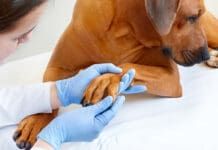I can still vividly recall the panic I felt five years ago when I looked up to see my beloved Bouvier, Axel, then 12 years old, stretch out his neck, give a gulp, and swallow the IQube Puzzle Plush squeaky plush ball that he’d been sucking on.
I looked at him in disbelief; had he really just quaffed that thing? And should I try to get him to throw it back up?
For most of us, seeing our dogs swallow a toxic item, whether it be a toy, medication, food product or what-have-you, is one of the most frightening pet parent moments. If your dog swallowed something harmful, would you know if and how to induce vomiting?
In Axel’s case, I didn’t even try, and quickly took him to an emergency veterinary clinic where they made my dog vomit. Despite their efforts, the ball remained in his belly. We were given the okay to take him home and observe him for any signs of discomfort.
Today, my husband and I share our home with an adolescent Bouvier, Atle. While Atle is no more prone to eating inappropriate items than the next adolescent dog (that is, fairly likely!), I’ve decided it’s high time that I learn how to make my dog throw up in an emergency.
How To Induce Vomiting in Dogs
Dr. Jennifer Pittman is a critical care specialist at BluePearl-Georgia Veterinary Specialists in Atlanta, where she spends most of her time in the ICU and ER, and sees anywhere from 4 to 10 toxicity cases a week. As a Diplomate of the American College of Veterinary Emergency and Critical Care, toxicity is right up her alley – and she would like the opportunity to consult with a pet owner before said owner induces throwing up.
“There are things that we don’t want to come back up,” Dr. Pittman warns.
Also, inducing vomiting is not without risk of potential complications, such as aspiration of vomitus, which could lead to the development of pneumonia. Talking with a veterinarian beforehand lets you weigh what your dog has ingested against the risk of making the dog vomit. If your Chihuahua eats one Hershey Kiss, for example, it’s likely he’ll be okay, so inducing vomiting can probably be avoided.
Conversely, is your dog throwing up on their own, without inducing? If your dog eats something they shouldn’t, it’s possible they’ll vomit it up themselves. There are some situations, however, in which dogs vomit because they are ill, such as if they have pancreatitis, gastritis, IBD, Addison’s disease, or liver disease. Know why your dog is throwing up, and do not try to induce vomiting if the dog has already done so.
3% Hydrogen Peroxide Makes Dogs Vomit
Hydrogen peroxide (H2O2) is the therapy to use should you need to make your dog vomit. The solution works as a direct irritant to the dog’s gastric lining; in a perfect world, the dog vomits fairly quickly after administration.
How Much Hydrogen Peroxide to Give Your Dog?
The dose of hydrogen peroxide is small: 1 teaspoon per 5 lbs of the dog’s body weight, with a maximum of 3 tablespoons. There are 3 teaspoons per tablespoon, so the maximum dose for dogs who weigh more than 45 lbs is 3 tablespoons per dose.
If the H2O2 works its magic, your dog should vomit within two to five minutes of receiving the first dose. If he doesn’t vomit within five minutes, it’s okay to re-dose. Then stop. Dr. Pittman warns that if your dog does not vomit within 10 minutes, you should be on your way to the vet. Do not administer more than the suggested dose. If given an exceedingly large dose of H2O2, the dog’s stomach could rupture!
Below, we discuss how to give your dog hydrogen peroxide in order to induce vomiting.
When Do You Need to Make Your Dog Throw Up? When is Inducing Vomiting Dangerous for Dogs?
Although Dr. Pittman says that she hesitates to provide hard and fast rules of when we should absolutely induce vomiting, she does have some general guidelines for different situations:
When to Make Your Dog Vomit Immediately:
If you see your dog ingest antifreeze, induce vomiting immediately. Anti-freeze is very rapidly absorbed across the gastric wall; within 30 minutes or less of ingestion, enough antifreeze has already been absorbed by your dog’s body to cause kidney toxicity. And then get your dog to a veterinary clinic ASAP.
When You Should Make Your Dog Throw Up:
If your dog ingests human medication or a goodly dose of another dog’s medications, it’s a good idea to make the dog vomit. “That would be a time I’d say to induce vomiting regardless,” Dr. Pittman advises.
Circumstances Which It Depends on What Your Dog Swallowed:
Say your dog swallows a golf ball or your daughter’s teddy bear. Depending on the size of your dog versus the object, inducing vomiting might be a good idea, but many times, the object needs to be removed with an endoscope. In these cases, confer with your veterinarian regarding the probability that the object could make it back up your dog’s throat if vomiting was induced.
You Probably Should Not Make Your Dog Vomit If:
Your dog drinks an acidic substance such as bleach or a household cleaner, or eats a sharp-edged item. Inducing vomiting in these cases is more safely accomplished under the direct supervision of a veterinarian who can weigh the risks and benefits and act quickly if the plan goes south.
Do NOT Make Your Dog Throw Up If:
If your dog is sedate, comatose, or displaying signs of neurologic impairment or seizures, do not induce vomiting. Dr. Pittman says, “The dog must appear clinically normal when you try to induce vomiting.” If he’s not normal, do not induce vomiting; you run a high risk of complications from aspiration.
Although it’s best to act within an hour of ingestion, inducing vomiting can be effective up to four hours post-ingestion in some cases. The caveat is that you should always consult a veterinarian or one of the veterinary phone consult toxicology services before inducing vomiting!
Who to Contact If Your Dog Eats Something Toxic
Your initial call for advice can be to your local veterinarian or a poison control hotline. If your dog has ingested something fairly pedestrian (yet still potentially dangerous) such as a box of dark chocolate, a pound of raisins, a bulk package of gum containing xylitol, or other potentially toxic food products, odds are that your vet can adequately advise you. If your dog’s choice of poison is something more exotic, such as a cocktail of grandma’s beta blockers, statins, and anti-anxiety meds, you’d be better off making your first call to an animal poison control hotline.
There are two phone consult toxicology services, both offering consultations 24/7 and run by veterinarians:
1. ASPCA Animal Poison Control: (888) 426-4435. Fee: $65 payable at time of call by credit card.
2. Pet Poison Help Line: (855) 764-7661. Fee: $39 payable at time of call by credit card.
When you call, you’ll provide the consulting veterinarian with the details of what your dog consumed, his age, weight, and other pertinent facts, and in return you’ll get a case number. The benefit to doing this before traveling to your vet clinic, or even en route (if someone else is with you and they are driving) is that by the time you reach the clinic, your veterinarian can call the service back with your case number and hit the ground running.
Dr. Pittman notes that many veterinary clinics themselves will err on the side of caution and consult poison control for two reasons:
-To check for updated information about recent toxicities and newer formulations of drugs and combinations; many drug interactions are not commonly known.
-To document the case and build a bank of information for treatment of future cases.
“In a perfect world,” Dr. Pittman says, “you’d initiate contact with your local vet and contact the service at essentially the same time.”
Administering the Hydrogen Peroxide to Your Dog
A syringe is the first choice; it enables you to measure the dose precisely, and squirt it right into the back of the dog’s mouth.
If your dog is prone to eating odd things, keep an unopened bottle of peroxide (so that it’s unoxidized and fizzy-fresh if needed) and fasten a syringe to the bottle with a rubber band, so you have everything you need in an emergency.
Another tactic that Dr. Pittman finds useful is to soak a piece of bread with the measured dose of hydrogen peroxide and immediately feed it to the dog.
Don’t be disappointed if your pooch doesn’t produce. “In the majority of cases, trying to induce vomiting at home, unfortunately, is not as successful as we wish it would be. Don’t be disappointed when it doesn’t work, and know that you’re not alone,” says Dr. Pittman.
Whether the induction “works” or not, your next move is to head immediately to your dog’s veterinarian or veterinary emergency clinic.
If you succeed in getting your dog to vomit, it’s helpful to clean up and bring the vomitus with you to the vet’s office. “That’s probably the least glorious part of this whole process,” says Dr. Pittman. “If you’re worried that your dog ate four pills, we’ve got to search through that mess and try to identify those four pills.”
Save the Vomit for the Vet?
Yes and no. “Absolutely, we’re happy to evaluate what came up,” says Dr. Pittman. That said, even having the vomit won’t solve all the mysteries. “But some medications, like gel caps or rapid release formulas, dissolve the minute they hit the stomach, so we’ll never find those.” But if fragments of the pills are found, it can make a huge difference in the next course of action, says Dr. Pittman: “The difference in the pills still being there versus them not, may mean three days of hospitalization.”
The Toy in My Dog’s Belly
Axel’s ball remained happily ensconced in his belly for about six months. Then, as these things are bound to happen, it re-emerged as a threat when we left Axel with a pet sitter and vacationed in Italy. When the sitter called to report that Axel was lethargic and not eating, all we could think about was the “smoking gun” of that darn ball. Blood tests and x-rays revealed nothing else askew.
I’m not sure that we would have elected for exploratory surgery had it not been for the missing toy, but fortunately, we did. The surgeon opened him up, removed the ball from his stomach – and happened to notice that his liver looked inflamed and infected. The focus of treatment became the liver infection; the stray ball wasn’t the cause of Axel’s malaise at all, but fortunately, it led his vet right to the real problem.
So as it turns out, if I had made my dog puke and gotten the ball back months before, we probably would have declined exploratory surgery and failed to find and treat the liver condition in time. Nevertheless, I’m glad to know now what to do if Axel’s successor, Atle, swallows something he shouldn’t.
Lisa Rodier lives in Georgia with her husband and Atle the Bouvier, and volunteers with the American Bouvier Rescue League.







Thank you for this help. We got up in the middle of the night, and there was a mouse running in the sun porch. I had just put down a D-Con mouse bait block the day before behind a large bookcase where I knew he was living. My Alaskan Husky dog darted after the most-likely-poisoned mouse and caught him, and ran off with the mouse in his mouth. I got online for advice, and found this page. Thanks to this advice, with no vet hospital open at 12:00 AM, I was able to put 3 TBL. of hydrogen peroxide in a cereal bowl, and then use a piece of bread to absorb it. I offered it to him, and he ate it without hesitating. Within 5 minutes he began vomiting up his stomach contents. Luckily there was even still dog kibble in it from earlier, so I feel confident now that he will be fine. Getting online also taught me that dried instant mashed potatoes can be be used as a non-toxic mouse poison. They eat it dry, and can’t digest it and it kills them – but never your dog or cat!
I cannot find anything on making them throw up without peroxide, and it’s very unfortunate to others who are in circumstances that are unable to get it
(Camping, etc)
You should create a travel or camping emergency kit containing peroxide and other things that may be needed if you were ever stranded or had an emergency such as this while camping… It is also smart to also keep one of these kids in your car just in case you were ever to get stranded somewhere… It should include things such as non-perishable food, a blanket, it should contain first aid items even if you have to make little vials of pre-measured hydrogen peroxide, materials to be able to make a sling if need be for the dog, tweezers in case it gets a thorn or sharp object in the Paul and you are an able to pull it out by hand, Also making sure that the items you include in this kit are specified to the dog size just an example if you had to create a sling for your dog you would not include A piece of material small enough for a Chihuahua if you have a great Dane… If you are an avid hiker this is honestly a really good thing to have things can happen anywhere and if your dog is a companion that joins you a lot just as you would include a first aid kit for yourself you should always have one for your dog… I hope this helps… Yours truly an avid dog lover and service animal handler And trainer!🐾🐾🐾
Did you find anything? I cant either😥
I find this article to be “fairly” good but when it comes to the advice on vomiting objects back up as well as leaving them in the dog for several months I don’t think this is very safe advice so I can’t bring myself to share it.
It works!! I used 1 teaspoon of HP per 5lb of my dog. He vomited up the tampon he ate. Bad dog! Happy family. THANK YOU.
Thank you I think you site just saved my dog from Sudafed overdose. I stuck my finger way down his throat several times and nothing but I have him the dropper full of peroxide and less than five min he threw it up all pink from the red Sudafed.
My dog ate a whole box of Sees candy and I gave him hydrogen peroxide and he vomited everything out. What do I do next?
OMG sees candy is CHOCOLATE! I know this is late, but to anyone in the same situation, if your dog eats chocolate, take them to the vet immediately! Even if you “think” they vomited everything out smh
honestly – milk chocolate is probably fine. A dog would have to eat a TON of that to become poisoned. Cocoa powder, or more “pure” chocolate, yes. I think Jessi was fine with what he did.
This is literally a miracle worker, every single time my dog or my friends dogs have eaten something they shouldn’t have we’ll give them three tablespoons as they’re big dogs and within 5-15 minutes they’re up chucking their entire stomach contents.
It has saved more dogs then I care to count, I’ve got dogs that are Houdinis and every once in while they’ll get into something they shouldn’t have just tonight my pup got into the bathroom and got a hold of some of herble supplements and calling my emergency vet they asked I’d given him this I said yes and I said he up chucked what looks like everything in his stomach, now I’m just monitoring him to see if anything changes other then him acting dumpy because of the vomiting which is normal.
It also works great on cats too dosage is very different then dogs but if you’ve got a cat that gets into everything it’s a great trick but most just throw up on their own for some reason.
You should never give cats hydrogen peroxide. They are very different from dogs, and while hydrogen peroxide can be used as a relatively safe way to induce vomiting needs dogs, it is not recommended for cats at all.
well my dog didnt throw up so now what. its 10:30 at night and there no vets open till 7 am
pls pls tell me what you did as i’m in the same boat💔 and also if i don’t take him to the vet and he ingested the hydrogen peroxide but didn’t throw it up what will happen?
My dog ate something around noon yesterday and I gave her the peroxide at that time. She didn’t throw up until 9am the next day. She threw up the object in question as too. So we are out of the clear. I know that’s a long time and I was concerned about it getting stuck but she’s really good at passing things since it’s happened before but this was a big object 😱 2 feminism pads 😳 we are all good though
My dog ate a half a Motrin 800. Within a few minutes I gave him 2 doses peroxide (total of 2 tsp all together). Peroxide worked as it has before with my prior dogs and using peroxide. It’s been a few hours and he has vomited a few more times now. He is acting totally fine and playful but I am nervous why he is still vomiting? No blood in vomit. Could the peroxide have hurt his stomach? It’s 4 in the morning now and I’m perplexed
[url=https://yourshorttermloans.com/]lenders[/url] [url=https://verlending.com/]no faxing payday loan[/url]
Step By Step Guide On: How To Make A Dog Throw Up?
Had to do this twice when Diana pawPrints was a puppy. Both times she ate the medication intended for my parent’s senior dog.
Nice tip about the dried instant mashed potatoes. I will have to try that. I lock the mouse blocks in a trap so the dogs can’t get them.
My parents had a close call with their Candy when she got into the mouse poison. My Dad assured me it wasn’t enough to effect her at her weight but she looked very unhappy so I googled the ingredients and we were off to the emergency animal hospital immediately. They ended up keeping her over night until they could get her blood to clot. She was very lucky she didn’t have a bleed or we would have lost her. I warned my Dad after that, no more mouse poison. That was one instance in which you do not want to indue vomiting as it was already in her system.